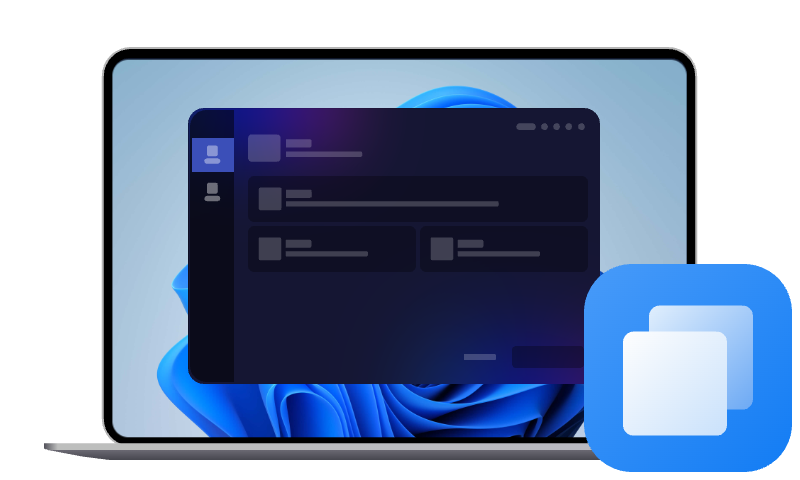Quick Guide: Clone Hard Drive in Windows 7 without Reinstalling
In this article, you will learn how to clone hard drive in Windows 7 without reinstalling, especially useful for a failing drive. Scroll down to explore more.
"Hello! So a family member's Windows 7 Professional laptop HD started showing signs of dying. A friend of mine recommended cloning the hard drive to a new one or SSD with a USB Dock since the rest of the labtop still works perfectly.
I have never done this, so I have some questions I haven't been able to get a clear answer to by googling. Thanks for the replies in advance, and I might have some follow-up questions, so bear with me.
- Can it be done with a USB Dock?
- Would it boot up like the current Hard drive that's in use?
- Would I need to reactivate Windows with an OEM key?
- Would everything transfer over, or just the OS?"
Does Windows 7 Have a Cloning Tool?
Unfortunately, Windows 7 does not include a dedicated disk cloning tool. It only provides the "Backup and Restore" feature, which can create a system image backup, but that’s not true cloning.
It requires you to restore system image to new hard drive or SSD before you can boot from it, whereas cloning creates an immediate, bootable replica. Also, it only includes OS, necessary partitions, and all data on the system partition, making it ideal for system migration or disaster recovery.
If that’s not what you want, look for a real Windows 7 hard drive and SSD cloning software like AOMEI Cloner. With it, you can choose to clone system partition or entire disk and boot from the new hard drive or SSD successfully. It also supports cloning specific partitions.
❤❤❤ Why Choose AOMEI Cloner?
- 👑 Bootable clone - Clone OS or entire disks without boot issues.
- Intelligent clone (default) - Clone the only used sectors of a drive, making it easier to clone large HDD to smaller SSD without capacity issues.
- Edit Partitions - Adjust partition size while cloning hard driveto larger drive, especially those with different disk partition styles(one MBR, one GPT).
- SSD Alignment - Align HDD and SSD with 4k technology and improve their lifespan.
- Disk compatible - Compatible with Samsung, WD, SanDisk, Crucial, etc., whether they are NVMe, PCIe, M.2, SATA, or mSATA interface.
- OS compatible - Supports Windows 7, 8, 10, 11 and Windows Servers.
How to Clone Hard Drive in Windows 7 (3 Steps)
✅What Do You Need:
- Clean up your Windows 7 drive: You can choose to uninstall useless programs, delete junk files or large files, etc., to better fit the target drive.
- Check the disk space: Be sure the used space of the original drive is smaller than or equal tothe target drive. Otherwise, the cloning process may fail.
- Prepare a compatible cable or adapter (if necessary).
- Backup files: The partition(s) on the destination disk will be overwritten or deleted. Please backup data in advance if there is.
- 👍Pro tip: Before cloning, you need to enable AHCI mode in the BIOS to maximize performance, especially for older Windows 7 systems. Setting the BIOS to IDE/Legacy mode will cause the SSD to run slower.
Step 1. Connect the new hard drive or SSD to your computer. Then, open AOMEI Cloner after installing. Click Clone > Disk Clone subsequently.
Step 2. You will then be asked to select the source and destination disk (usually with equal or larger capacity). Click Next after each selection.
- ⚠️Warning: The existing partitions on the destination disk will be overwritten or deleted. Please be sure you select the right drive and backup your data (if there are) in advance. Then, click OK to continue.
Step 3(Important). Be sure to check the SSD Alignment feature to align HDD and SSD for better performance. You can also enjoy the Edit Partitions feature in the following two situations. Then, click Start Clone to clone hard drive in Windows 7.
- The target SSD drive is larger. Select “Add unused space to all partitions”or “Manually adjust partition size”, which can avoid unallocated space left after cloning.
- Both drives have different partition styles (one MBR, one GPT). Check the option “Convert the destination disk from MBR to GPT”or vice versa to make them identical.
By default, this software will enable the intelligent clone feature, which clones only used sectors of a drive. So you don’t need to worry about boot issues (if the target disk is smaller).
Download AOMEI Cloner to clone hard drive in Windows 7! It also supports Windows 8/8.1, 10, 11 and Windows Servers.
Secure Download
Why Do You Need to Clone a Hard Drive?
Cloning a hard drive is to make a duplicate copy of the original drive and migrate OS & all data to another one, either HDD or SSD. So you don’t need to reinstall Windows and programs. Also, here are some key advantages of it:
- Clone Windows 7 to a new, larger hard drive, especially crucial when Windows prompts “Low disk space” and asks you to manage your storage space, indicating that you are indeed significantly low on disk space.
- Replace a failing or old drive. Every hard disk usually lasts 3-5 years, and is likely to fail or significantly degrade in performance over time. That’s when it’s time to clone Windows 7 to new hard drive or SSD.
- Boost computer performance with SSDS. By comparison, SSDs usually have a higher performance, e.g., faster boot time, file loading speeds, etc., which are a popular choice for users who want the highest performance possible.
- Duplicate copy for disaster recovery. The cloned replica is bootable and, in case of a disaster, can be used to directly replace the original drive without any interruption. Meanwhile, just for safety, it’s necessary to create a replica copy since Windows is already obsolete on January 14, 2020.
Conclusion
With a reliable hard drive and SSD cloning software - AOMEI Cloner, you can easily clone hard drive in Windows 7 to new hard drive or SSD and boot from it successfully without reinstalling Windows.
It has a very user-friendly interface that is easy to operate for all users. Just a few taps are all it takes to complete the operation. It also takes care of all the cloning issues, such as SSD slow performance after cloning, etc.
FAQs
Q1: Can I clone a failing Windows 7 hard drive?
You can try, but it's safer to create a disk image first if bad sectors are involved.
Q2: Can I clone Windows 7 to a larger SSD?
Yes! Cloning Windows 7 will create an exact copy of the original drive, but the remaining space will be displayed as unallocated space unless you resize it during the cloning process. Make sure your software has this option.
Q3: Will the cloned drive boot immediately?
Yes, if you use a reliable cloning software like AOMEI Cloner. You need to change the boot order in BIOS first. If necessary, change the boot mode from Legacy BIOS to UEFI or vice versa.
Q4: Is it necessary to format the new SSD before cloning?
Nope! Most cloning software, including AOMEI Cloner will handle partitioning and formatting automatically during cloning.
Q5: Why does my cloned hard drive won't work in Windows 7?
You’d better check the boot mode if your Windows 7 does not boot from new hard drive or SSD. Note MBR disks use Legacy BIOS as boot mode while GPT disks use UEFI mode.
You can find an option similar to Boot Mode, UEFI/Legacy Bootor CSM (Compatibility Support Module)in the Boot or Advanced tab. Please enable Secure Boot for UEFI(required for Windows 11)as well.

